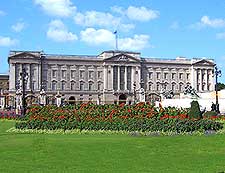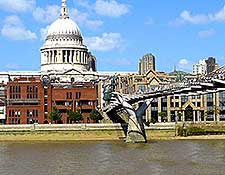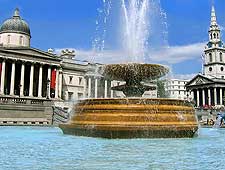London History Facts and Timeline
(London, Greater London, England)

London's first appearance in the history books is during the Roman invasion of Britain, around 43 AD. Prior to the arrival of Roman forces, the site had most likely been populated by Celtic tribes.
The Romans built a crossing over the River Thames, somewhere near the present-day London Bridge. A town grew up around the crossing and it wasn't too long before Londinium, as it became known, was an important port. By the 3rd century AD it was also the administrative and commercial centre of Roman Britain and a substantial town. Around 30,000 people lived here and there were all manner of amenities, including paved streets, temples, public baths and miles of thick stone walls.

From Saxon Town to Medieval City
When the Romans eventually withdrew from Britain, London fell back into obscurity. For the next 500 years, London was little more than a small trading town, subject to intermittent periods of Danish and Saxon rule. Finally, in 883 AD, King Alfred drove out the Danes for one last time, rebuilt the defensive city walls and appointed his son-in-law Ethelred as the governor of Lunduntown. Gradually, it grew larger and more prosperous.
The city's preeminent position in England was retained following the arrival of the Normans in the 11th century. After his coronation in Westminster Abbey, William the Conqueror built many fortresses within the walls of the city. Other Norman building projects included the Tower of London, and the Old London Bridge, which replaced the original Roman crossing.
It wasn't until the 14th century, however, that London could start to call itself the real capital of England. Under King Edward III, the city's place as the seat of government and law was affirmed. The city grew steadily, both in size and population. There were setbacks, of course. Throughout the Middle Ages, power struggles took place here between the church, the city guilds and the monarchy. London was also devastated by disease caused by poor living conditions. In fact the Black Death of 1348 killed two-thirds of the city's inhabitants.
From Tudor Times to the 17th Century
By the time that Elizabeth came to the throne, London was home to some 200,000 people. In 1599, Shakespeare's original Globe Theatre was built here. Then, in 1666, disaster struck London. The Great Fire virtually razed the city to the ground, with most of its medieval and Tudor architecture disappearing in one fell swoop. The restoration of the city in the years that followed included the building of many new churches by the architect Sir Christopher Wren, including St. Paul's Cathedral.

18th Century History to the Present Day
By 1750, a population explosion forced the city to expand both eastwards and to the south. Meanwhile, London's wealthier residents headed to the north and west of the city. There was no doubting that Georgian London had become the political and administrative centre of Britain, and it was also at the heart of the arts and architecture. Handel wrote 'The Messiah' here in 1742. Many writers were born and lived here, including Samuel Johnson and Charles Dickens. They frequented coffee houses, taverns and literary salons in the city.
During the early years of the 20th century, London was shaped by improvements to travel and transport, including the replacement of horse-drawn vehicles with more modern motor buses.
London was also shaped by war. The outbreak of World War Two was disastrous for the city. The Blitz of 1940 to 1941 reduced the central part of London and the East End to rubble. Many homes and businesses were lost, as were many historic buildings. The Festival of Britain was held on the South Bank of the River Thames in 1951 to encourage a sense of optimism in Britain's post-war recovery. One post-war development was a flood of immigrants from all over the British Empire, which helped to transform the capital into a truly cosmopolitan city.
In the 1960s, London took on a new persona as a centre for fashion and music. At its heart were Carnaby Street and Abbey Road, made famous by the Beatles. The city continues to attract crowds of tourists, who come to enjoy the plentiful historic traditions and endless attractions.
 London's first appearance in the history books is during the Roman invasion of Britain, around 43 AD. Prior to the arrival of Roman forces, the site had most likely been populated by Celtic tribes.
London's first appearance in the history books is during the Roman invasion of Britain, around 43 AD. Prior to the arrival of Roman forces, the site had most likely been populated by Celtic tribes.
